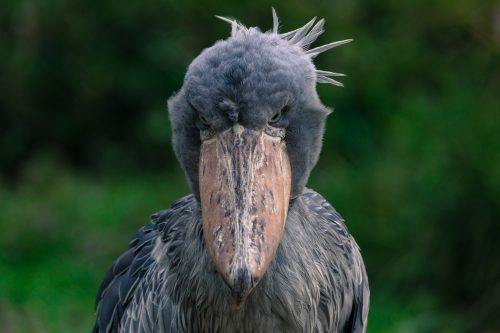The sandpiper, a strange African bird, has a unique origin and structure that may be an inspiration for light but strong designs in the field of engineering, in the field of design and in other fields / by: Adi Weiss

Among the unusual creatures you can find in Africa, there is also a bird with a somewhat prehistoric appearance, large in size, with a strange beak and wide legs - this is the cobbler, or in its Latin name - balaeniceps rex (loosely translated "royal whale-head"). Naelan has a familiar relative in Israel - the common pelican, which passes through Israel on its way from the north of the earth to the south and vice versa. But the similarity between the two is not great when it comes to the small details.
To researchers, the sandpiper looks like a strange fusion between a pelican, a stork and a heron, but it has its own special characteristics. First of all - this is a swamp fowl found only in East Africa, in tropical wetlands that stretch between Sudan and Zambia. The shoebills do not migrate, and due to the destruction of habitats, hunting and trade as pets, only 8,000-5,000 individuals remain in the wild - and the species is considered endangered.
Life in the swamps shaped the cobbler into an unusual shape; It rises to a formidable height for a bird - up to one and a half meters, and weighs up to six kilograms - therefore it is considered one of the heaviest birds in existence. His head is particularly large relative to his body, and his legs are thin and long, with long nails - and without swimming membranes like pelicans have.
Its unique beak shape is referred to by its name in languages such as Arabic and English - the cobbler has a massive shoe-like beak, up to 20 cm wide and up to 24 cm long, with a hook-like hook at the end. The hook is used by him, when catching lungfish, catfish and even young crocodiles that he has taken out of the water, to behead the prey. The source has great power, and together with its large eyes focused forward, it gives the cobbler the appearance of a creature from fairy tales. However, this is a generally gentle and quiet animal. The cobbler hunts by lying in wait for hours without movement for animals (this is how he also earned the nickname statue-like bird). The only times he makes a noise are during courtship ceremonies. Here, too, the source is used effectively, to produce sounds that to the human ear might sound like rifle cartridges.
Being a special fusion of different avian features, the mechanism of catching prey and the hunting style of the sandpiper are slightly different from those of its relatives. The shape of the beak and its many uses, as well as the structure of its thin legs, which are able to bear the weight of its relatively large body even over stagnant bodies of water, may be an inspiration for light but strong designs in the field of engineering, in the field of design and in other fields.
Sources: Africa Geographic, IUCN Red List, Animal Diversity
